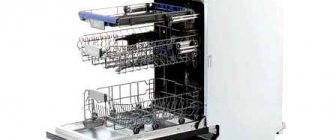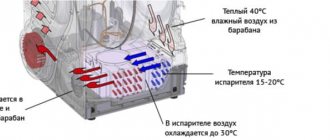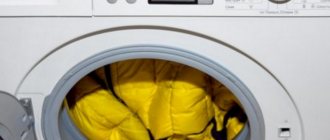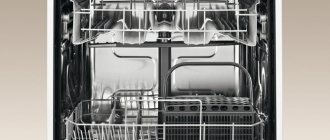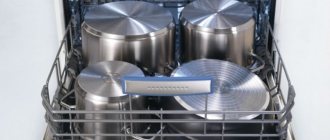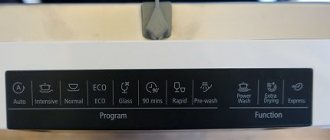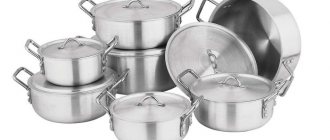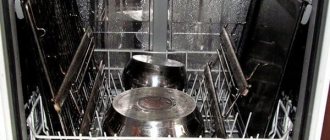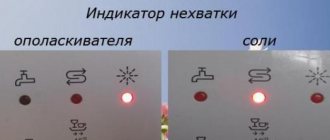To prevent drops of water from remaining on washed plates and glasses, each dishwasher (DMM) has one or another type of drying: condensation, convection, intensive or zeolite. Which dishwasher dryer is better, each user must decide for himself. Knowledge of the advantages and disadvantages of all types of household appliances, as well as his own preferences and priorities, will help him with this.
How the dishwasher and dryer work
Washing is carried out due to rotating 2 or 3 rocker arms, which are located mainly in the lower part of the PMM, sometimes in the upper part. The water is heated using a heating element.
Many dishwashers use a flow-through heater for this purpose. A microcontroller controls this entire process.
And after the washing cycle is completed, the drying process automatically starts, which takes, on average, from 15 to 30 minutes. The heating element is not necessarily activated.
The main types of drying that are integrated into modern dishwashers:
- Condensation
- Ventilation.
- Zeolite.
- Turbo drying.
- Intense.
They differ radically from each other, so the chosen type of drying really greatly affects the energy efficiency of the equipment.
Sources of failure
Developers and manufacturers of dishwashers strive to ensure maximum reliability of their devices. But this does not guarantee one hundred percent “protection from fools”, does not prevent natural wear and tear, or exposure to external factors of a technical nature. Therefore, when a dishwasher from such a well-known brand as Bosch does not dry dishes, it is necessary to establish the causes of the breakdown as accurately as possible. The most likely ones are:
- failure of the heating element;
- temperature sensor failure;
- faulty control module;
- inoperability of the fan pumping heated air into the tank (thermal drying);
Incorrect program selected
Symptoms: drying does not start at all or the dishes remain wet
The simplest reason is that you chose a program that does not involve drying at all. Different drying programs correspond to different types of dishes, and it is possible that you simply made a mistake and set a program that does not correspond to the loaded dishes (or simply forgot to change the program).
Condensation drying
Condensation drying is the most common type of drying used in dishwashers. Its main advantage is its low cost. The operating principle is as follows:
- After the end of the washing cycle, all dishes located in the chamber are doused with hot water. Steam is formed, which rises into the upper chamber and settles on the metal walls of the dishwasher (a natural process of moisture condensation).
- The dishes remain hot, so they dry automatically quite quickly.
- Remaining moisture flows down the walls into the outlet (sewer).
That is, no additional devices for this drying are installed in the dishwasher. Only the heating element is activated.
The main advantages of condensation drying:
- Technically, it’s very simple.
- It works efficiently and is installed in almost all budget dishwasher models.
- Hot water treatment indirectly kills various bacteria. Also, in such dishwashers, mold and mildew never form inside the washing chamber.
But this drying method also has disadvantages. And the most important thing is the duration of the drying process.
It takes on average 30 minutes. That is why PMM with such drying provides the ability to turn it off when starting the next cycle.
And it is not used when choosing a short wash mode (express wash, which takes a total of only 30 - 45 minutes). You also need to take into account that with this type of drying the heating element is actively used.
Therefore, electricity consumption is increased.
Quality levels
Types of drying differ in the technologies and classes used. According to the standards, the drying class is designated by Latin letters from “A” to “G” . Such markings must be present in the technical documents for the device.
To assess the effectiveness of this parameter, a specially developed index is used, the symbol of which is the “ ID ” sign. It can range from the theoretical ideal of 2 units to the lowest of 0 units.
The index is assessed by the number of wet streaks and marks with an area of no more than 50 cm². The presence of one or two residual traces after the end of the procedure reduces the index to one; a larger number of them reduces the index value to zero.
| Class | Index value | |
| 1. | A | more than 1.08 |
| 2. | B | 0,86–1,08 |
| 3. | C | 0,69–0,86 |
| 4. | D | 0,55–0,69 |
| 5. | E | 0,44–0,55 |
| 6. | F | 0,33–0,44 |
| 7. | G | less than 0.33 |
Turbo drying
Condensation dryers in dishwashers have been replaced by turbo dryers. Their key difference is the presence of an integrated fan that blows hot air inside the washing chamber.
The heating element is also used (as a rule, an additional one is used). The airflow is directed directly to the dishes.
Accordingly, the moisture evaporates, condenses on the walls of the dishwasher, and then flows down the drain.
Key advantages of this type of drying:
- Works fast. The drying process literally takes 3 to 7 minutes, depending on the load on the dishwasher, its total volume, and type (free-standing or built-in).
- This drying is activated even when a short wash cycle is selected.
Among the disadvantages, we can mention the high consumption of electricity, and the dishwasher itself has large dimensions, since it is equipped with a fan that is closed from moisture. An additional disadvantage is the noise during operation.
Either one large fan or several small ones are installed inside, which rotate at a fairly high speed. Therefore, in dishwashers with such drying, additional noise of 5 - 7 dB is created during operation.
For many, this is critically important (for example, if small children or pets live in the house).
Active users of dishwashers point out that PMMs with turbo dryers are the most difficult to repair. Accordingly, if any breakdown occurs, then with a high degree of probability you will have to contact an authorized service center.
Ventilation drying
Dishwashers with this type of drying have one key technical difference - they have an outlet for connecting ventilation. Accordingly, all moisture is “blown out” into the pipe into the street or into the ventilation system.
There is a fan at the outlet, which creates a reverse air flow. Naturally, it is not necessary to connect the ventilation pipe.
But in this case, all the moisture will accumulate in the kitchen (where the dishwasher is installed for most buyers of such equipment).
Key advantages of this type of drying:
- Low power consumption. As a rule, the installed fan, which creates the reverse air flow, consumes less than 10 W of electricity. And it only works for 15 - 20 minutes, which is more than enough to dry the entire washing chamber.
- All moisture is blown outside the room. Therefore, it is these dishwashers that should be preferred by those who do not have forced ventilation in their home (80% of private houses do not have it at all).
The main disadvantages of this type of drying in dishwashers:
- take up more space;
- it is necessary to connect the ventilation pipe (also requires more space for installation);
- drying is performed quite slowly (on average, it takes from 15 to 25 minutes, depending on the model of the installed fan and its performance).
Zeolite drying
Zeolite is a mineral that has a high absorption rate of ambient heat. In dishwashers it is installed at the bottom of the washing chamber.
Accordingly, when the cycle starts and hot water is sprayed inside, the mineral heats up. And after washing is complete, it heats the inner chamber, which ensures natural, uniform drying of all dishes.
In this case, neither the heating element nor the pump are used. After all, evaporating moisture condenses automatically on the walls, and then flows naturally into the sewer.
Key advantages of this type of drying:
- Does not consume electricity.
- This kind of drying will never break. It is simply impossible to damage the zeolite in any way. And it is reliably protected from dirt. According to the manufacturer, such drying will last more than 10 years without problems.
- After such drying, there are practically no streaks left.
- Absolutely environmentally friendly. Zeolite does not react with water, detergents, or food residues. It also does not promote the spread of mold.
The main disadvantage is the high cost of zeolite. Therefore, this type of drying is mainly used only in flagship models of dishwashers, which cost several times more than budget models.
Now there are trends towards a gradual decrease in cost. But still, dishwashers with zeolite drying are almost 2 times more expensive than those that use condensation or turbo drying.
And they take up a little more space. Often, such dishwashers are additionally equipped with a ventilation outlet, which allows for faster drying of dishes, but also negatively affects the overall dimensions of the equipment.
Model overview
Let’s see what models with the “hot air drying” function are on the market and find out what users say about them.
Electrolux ESF 9420 LOW
The device has a white body with electronic control and display. A flow heater is installed. In addition to standard washing modes, there is a BIO program, pre-soaking, and an express program. There is a delayed start and partial protection against leaks.
Specifications:
| Type | narrow |
| Installation | freestanding |
| Capacity, sets | 9 |
| Energy consumption | A |
| Washing/drying | A/A |
| Water consumption per cycle, l | 9,5 |
| Dimensions (WxDxH), cm | 45x62x85 |
| Number of programs/temperature modes | 5/4 |
| Approximate cost, rubles | 19 000 |
Advantages of Electrolux ESF 9420 LOW noted by users:
- Compactness - due to its small width;
- High-quality washing;
- Basket height adjustment.
Cons and noticed problems:
- There is no clean water sensor and automatic hardness detection;
- It does not turn on when it tries to drain water that is not in it;
- The powder tray does not open completely;
- Inconvenient watering can for pouring salt - everything crumbles;
- After three years of operation, the salt sensor failed;
- After 4 years of work, glitches appeared in the programs;
- It’s inconvenient to place glasses - they fall and break;
- Poor quality of washing in the lower level.
The main complaint of consumers is the high cost with obvious imperfections in the design. Let's see what other brands offer.
Hansa ZIM 476 H
The machine is 45 cm wide. The device has a display and electronic control. Noise - 47 dB. There is an economical program for lightly soiled dishes. Half load. There is a delayed start.
Technical specifications:
| Type | narrow |
| Installation | fully built-in |
| Capacity, sets | 10 |
| Energy consumption | A++ |
| Washing/drying | A/A |
| Water consumption per cycle, l | 9 |
| Dimensions (WxDxH), cm | 45x55x82 |
| Number of programs/temperature modes | 6/4 |
| Approximate cost, rubles | 15 000 |
Advantages:
- Complete protection against leaks;
- Good balance between price, quality and noise level;
- Saves water and time
Disadvantages noticed by users:
- No child protection;
- There is no automatic determination of the hardness level;
- Doesn't wash dry dishes well;
- Not roomy enough;
- Poor quality assembly;
- The dishes are not dry enough.
In general, users are unanimous - an excellent device for this price.
Asko D 5436 W
Floor-standing dishwasher 60 cm. Noise - 49 dB. Delay start up to 24 hours. Complete protection against leaks. The modification is equipped with a clean water sensor and a hardness detector. The use of “3 in 1” tablets is provided. The body is white. Weighs 67 kg.
| Type | full size |
| Installation | freestanding |
| Capacity, sets | 13 |
| Energy consumption | A+++ |
| Washing/drying | A/A |
| Water consumption per cycle, l | 10 |
| Dimensions (WxDxH), cm | 60x60x85 |
| Number of programs/temperature modes | 6/4 |
| Approximate cost, rubles | 50 000 |
Users note the impeccable cleaning and spaciousness of the equipment. The price is considerable, but it corresponds to the quality - as stated by the owners of this modification of the Asko PMM. Users also noted the following advantages:
- Quiet operation;
- Possibility to wash at night;
- Availability of economy mode;
- Basket adjustment.
Flaws:
- Lack of service center.
An excellent model for a large family and a spacious kitchen.
Asko D 5896 XL
Another dishwasher from Asko. It differs from the previous one in price and type of installation. Spacious camera. There is protection against children. A typical cycle lasts 210 minutes. It has a low noise level - 42 dB. There is a delicate wash and an economy program. Delay timer - 1-24 hours. Use of three-in-one tablets. Beam on the floor. Weighs 52 kg. There is internal lighting. The chamber is equipped with a cutlery tray and a holder for glasses, vases and bottles.
| Type | full size |
| Installation | fully built-in |
| Capacity, sets | 14 |
| Energy consumption | A+++ |
| Washing/drying | A/A |
| Water consumption per cycle, l | 10 |
| Dimensions (WxDxH), cm | 60x55x82 |
| Number of programs/temperature modes | 13/7 |
| Approximate cost, rubles | 125 000 |
This modification has earned compliments from users - from “everyone is happy” to “super”. What the owners of this expensive equipment praised:
- Quality of materials;
- Silent operation;
- Capacity;
- Availability of a retractable tray for cutlery;
- Functionality;
- Convenient display.
The owners of this car were silent about the shortcomings - perhaps they do not exist, or they faded against the background of obvious advantages.
Flavia BI 45 ALTA
Model from an Italian brand. Noise level - 47 dB. There is a half load and a water purity sensor. There is no hardness determinant. You can use tablets. Camera with light.
| Type | narrow |
| Installation | fully built-in |
| Capacity, sets | 10 |
| Energy consumption | A+ |
| Washing/drying | A/A |
| Water consumption per cycle, l | 9 |
| Dimensions (WxDxH), cm | 45x56x82 |
| Number of programs/temperature modes | 4/4 |
| Approximate cost, rubles | 27 000 |
“Flavia” is a brand under which only dishwashers are produced. They are moderately priced, but compared to famous brands they are inferior in quality. There are few advantages noted by users:
- Compartment for cutlery - spoons, forks, knives;
- Clear controls;
- Lighting in the chamber.
There are many more disadvantages. The owners of Flavia spoke about the following problems:
- Regularly displays error E4;
- Poor quality of washing;
- Sprinklers become clogged;
- The dishes have to be laid out, leaving a lot of empty space;
- Poor cleaning in the corners of the chamber;
- Only one year warranty;
- The camera's capacity is not enough for a family.
It is surprising that the company specializes in the production of dishwashers, but at the same time its products are inferior in quality to well-known brands. Flavia's PMMs received equal amounts of positive and negative comments.
Intensive drying
The operating principle is similar to that used in turbo drying. But there is one significant difference: in this case there is no fan.
How is air circulation ensured? Due to the built-in valve.
Due to the fact that during the washing process the air in the washing chamber heats up, while the outside temperature remains at room temperature, a pressure difference occurs (inside and outside). At this moment, the valve opens slightly, through which hot air is “blown out” in a slow flow.
This creates natural circulation inside the washing chamber. And then the remaining moisture condenses on the walls and flows into the sewer.
The main advantage of intensive drying is that it practically does not consume electricity (although some models still use a heating element in the process of drying dishes). But the drying process itself takes a lot of time.
And such a dishwasher is “sensitive” to heat. This is why intensive drying is almost never used in built-in models.
After all, with such a design it will work less efficiently.
Which type of drying is more profitable?
On absolutely all dishwashers, the manufacturer must indicate the energy efficiency class. The base consumption for the PMM is set at 462 kWh per year.
And in order to receive energy efficiency class A+++, equipment must consume no more than 50% of the specified value (that is, up to 231 kW/h per year). It should be taken into account that the average frequency of use of a dishwasher is considered to be 280 start cycles per year with a standard washing program (calculated for all dishes with a full load of the dishwasher).
Which dryer uses the least energy? Depends on whether the heating element is activated:
- Condensation Using a heater, the water is heated to a temperature of up to 70 degrees Celsius. Therefore, such drying is not the most economical in terms of electricity consumption.
- Turbo drying. This uses not only a heating element, but also a fan that blows hot air inside the dishwasher. Electricity consumption is the highest. But drying also takes a minimum of time.
- Ventilation. The consumption is relatively small, since only the fan is used, consuming only 5 - 20 W of electricity. But the drying process itself takes longer. Also, such dishwashers make a little more noise during operation than others.
- Intense. Conventionally, such dryers are of two types: with natural circulation, and also with an additional heat exchanger. In the second case, the electricity consumption will be approximately 30–50% less than in condensation drying. If only natural ventilation is used, then the current consumption is minimal, but the drying process itself takes longer.
- Zeolite. Does not consume additional electricity. The pump can only be used to pump water into the sewer system (if it is designed for this purpose). Such dishwashers are the most economical, but they also cost an order of magnitude more than other models.
Now in many modern dishwashers there is also the so-called “combined” drying. That is, several mechanisms are used to dry the dishes after the washing is completed. As a rule, they consume less electricity than condensing ones. But in technical terms, this is a more complex technique. Therefore, you will not be able to repair it yourself if it breaks.
Troubleshooting
Below we will look at ways to replace parts; as for the heating element and temperature sensor, in case of their breakdown, only complete replacement of their components will help. Below is a detailed description of each element:
- In almost all Bosch dishwashers and models from other manufacturers, heating elements are located in the lower part of the structure at the very base. To dismantle it, you will need to turn the unit on its side and remove the pan. You can check its performance using a multimeter. If it is necessary to replace the heating element, it is advisable to use a new and original part;
- The temperature sensor is located in the opening of the chamber, which is designed to discharge water. Be careful, in some models this chamber also has a sensor that measures the purity of the water. Replacing the temperature sensor will not cause any particular difficulties; you will need to remove the wires from it and install a new one in place of the old one. Next, you need to check the functionality of the dishwasher.
Now consider the breakdown of the ventilation system and control relay:
- The relay is located on the control board, which is hidden in the dishwasher door. Having disassembled the door, you will find two such elements there; to replace the relay you will need the skill of using a soldering iron. However, if you are afraid of damaging the board or are not confident in your abilities, it is better to contact a specialist; this repair is not expensive;
- With the ventilation system, everything is more complicated, since it cannot be repaired; only a complete replacement of the unit will help you. It is quite easy to determine that it has stopped working - you will not hear a characteristic sound during the drying process. In all models, the fan is installed differently, it all depends on the design of the dishwasher. You will have to disassemble quite a few parts of the machine to find out where this system is located, if you are not afraid of this then go ahead. But if something happens, it is better to contact a specialist who knows the entire design of the unit.
We looked at the main reasons why a dishwasher does not dry dishes; in some cases, you may need the direct intervention of a technician, since the breakdown may be much more serious than you thought.
What repairs will be required if the machine does not dry dishes?
The technician can change the heating element, fan or sensor. The control system is usually reflashed, but replacement is also possible if the unit is faulty. The technician will be able to name the exact cause of the breakdown, as well as the cost of repairs, only after diagnosis.
Which one to choose?
But which one to choose depends only on the individual requirements of the buyer himself, as well as the available budget allocated for the purchase of a dishwasher. The following conclusions can be drawn:
- Condensation drying is the best choice for those who want to save money on their purchase. After all, it is this drying technology that is used in budget-class dishwashers. But in terms of ease of use, it is in no way inferior to its competitors. And servicing such a PMM is quite simple.
- Turbo drying is an option for those who have to wash large volumes of dishes. That is, it is recommended to buy PMM with turbo drying for those whose family consists of 4 – 5 or more people. By the way, this type of drying is preferred in catering establishments, where the same set of dishes has to be washed several times every day (both from visitors and directly from the kitchen).
- Ventilation drying. A good choice for those who have space to install a dishwasher and connect a ventilation pipe to it. Such drying consumes a minimum of electricity and does not in any way affect the atmospheric humidity in the place where it is installed.
- Intensive drying. It can be considered a more technically advanced version of turbo drying, but with less electricity consumption. But, as a rule, such drying is used only in dishwashers of flagship categories (or those close to them in cost).
- Zeolite drying. The best in all aspects, but a dishwasher with zeolite will cost much more. It should also be noted that the number of such dishwashers presented is relatively small. That is, there is no guarantee that the buyer will be able to choose a PMM that optimally fits the design into the interior.
In total, there are 5 main types of dryers that are used in modern dishwashers. Each of them has its own advantages and disadvantages.
Zeolite is truly one of the best. But turbo drying still works faster.
Therefore, each buyer first needs to figure out what is more important to him: quick drying or minimal electricity consumption and reliability of equipment. And after that you can go to the store.

